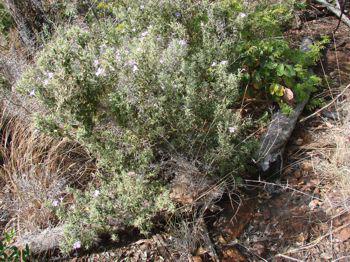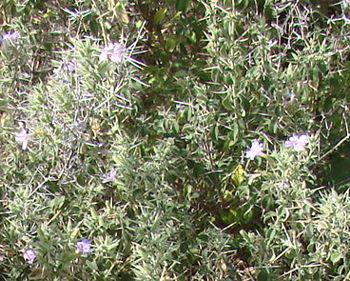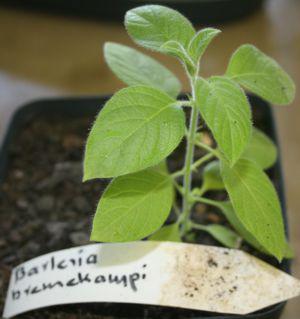Barleria bremekampii
Barleria bremekampii Oberm.
Family: Acanthaceae
Common names: hedgehog barleria (Eng.)
Introduction
If you are looking for a water-wise prickly hedge or barrier plant, Barleria bremkampii is your answer.

Description
Description
An armed, well-branched shrub, up to 1.3 m high. Auxillary spines are long and 2–clustered. The leaves are petiolate, elliptic, the apex (leaf tip) ending in a sharp point. Leaves and branches are densely covered with white hairs.
Flowers are mauve, in 1–6, one-sided cluster of flowers. Corolla 2-lipped, the upper lip 2-lobed and the lower lip 3-lobed. The upper 2 lobes are smaller than the 3 lower lobes. Corolla tube cylindrical and yellow. The corolla is subtended by hairy, elliptic to oblong calyx lobes, with spinous apexes. Flowering time is from February to June, and flowers appear sporadically.
Fruit is a capsule with a short beak, with 4 seeds.
Conservation Status
Status
Barleria bremekampii is Red Listed as LC (Least Concern).
Distribution and habitat
Distribution description
This plant occurs in Zimbabwe and in South Africa, in the North West and Limpopo provinces. Plants grow in bushveld areas on rocky outcrops between other bushveld vegetation under sunny or semi-shade conditions. Plants tolerate light frost and thrive in well-drained soils, and are drought resistant.

Derivation of name and historical aspects
History
This species was named after Prof. Cornelis Bremekamp a Dutch Botanical researcher and professor at the Transvaal University in Pretoria {1903-1977}. He went on collecting trips to the Northern Transvaal (Now Limpopo Province), Rhodesia (Now Zimbabwe) and Mozambique.
Ecology
Ecology
Barleria bremekampii is pollinated by insects and attracts various species of butterflies. Ripe seed capsules explode when moistened, to distribute the seed.
Uses
Use
Barleria bremekampii is recommended as a garden subject. It does well as a shrub or as a hedge.

Growing Barleria bremekampii
Grow
Barleria bremekampii can be propagated either by seed or cuttings.
Collect the seed as the capsules turn brown. Open the capsules and harvest the seed. Fertile seeds are well developed. Plant the seeds in a mixture of equal parts of coarse river sand, soil and compost from October to March. Place the container with seed in a shady spot and water once a week. Seed germination takes place after 6–10 days. Transplant the seedlings into containers when they are 100 mm in size.

Barleria bremekampi can be grown from cuttings, but it is difficult to do so. Take semi-hardwood cuttings, 120 mm in size, in summer, and treat the cuttings with a hormone powder to stimulate root growth. Use a mixture of even parts river sand and a bark potting mixture as a growing medium. Put the container in a shady place and water twice a week. Transplant the rooted cuttings after 3–4 months. Expect a success rate of 10%.
Barleria bremkampii is a water-wise plant and does well in sandy and loam soils.Use it in combination with other water-wise plants such as Portulacaria afra (spekboom), Aloe marlothii subsp. marlothii (mountain aloe) and A. chabaudii. To establish a hedge, plants should be planted 500 mm apart, in full sun, and pruned lightly every three months to stimulate new grow to form a firm hedge.
References
- Raimondo, D. et al. 2009. Red list of South African plants. Strelitzia 25. SANBI (South African National Biodiversity Institute), Pretoria.
- Retief, E. & Herman, P.P.J. 1997. Plants of the northern provinces of South Africa: keys and diagnostic characters. Strelitzia 6. National Botanical Institute, Pretoria.
- Obermeyer, A.A. 1933. A revision of the South African species of Barleria. Annals of the Transvaal Museum 15,2: 162–164.
Credits
Willem Froneman
Lowveld National Botanical Garden.
March 2015
Plant Attributes:
Plant Type: Shrub
SA Distribution: Limpopo, North West
Soil type: Sandy, Loam
Flowering season: Late Summer, Autumn
PH: Neutral
Flower colour: Mauve/Lilac
Aspect: Full Sun, Morning Sun (Semi Shade)
Gardening skill: Challenging
Special Features:
Horticultural zones








Rate this article
Article well written and informative
Rate this plant
Is this an interesting plant?
Login to add your Comment
Back to topNot registered yet? Click here to register.